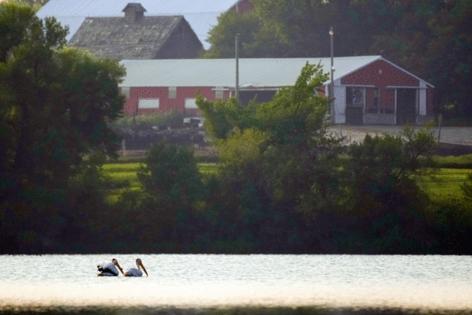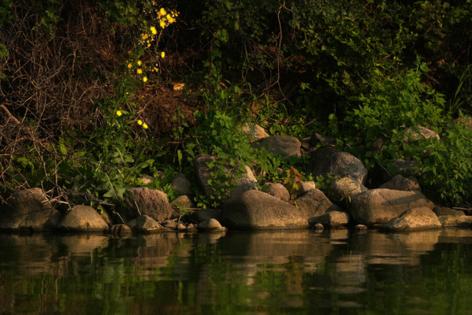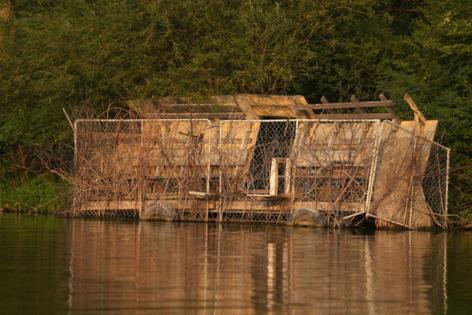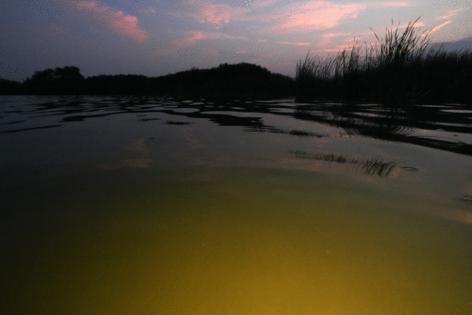Where only the carp can thrive: Meet Ocheda, one of the unhealthiest lakes in Minnesota
Published in Outdoors
MINNEAPOLIS — One of the unhealthiest lakes in Minnesota is 5 1/2 miles long and stretches into three pools that, when viewed from above, look like a wasp about to sting. It’s a few miles north of the Iowa border in the city of Worthington, where its waters, cloudy with muck and festering algae, choke out the sun.
In Lake Ocheda few plants grow. Only carp seem to thrive, turning over the lake bottom again and again, swarming and splashing in an otherwise barren basin of bacteria.
The lake was loved once. And clear.
Through 150 years of decisions great and small, Lake Ocheda became one of the most degraded and polluted lakes measured in Minnesota.
Its future may now rely on a somewhat desperate plan to completely drain the lake and keep it dry for two years, in the hope that cleaner water will refill it.
The transfusion, however, won’t save Ocheda forever. Without major changes to the ditches and drainage pipes that surround it, experts say the lake will eventually slip back into a state of filth.
The Minnesota Department of Natural Resources started issuing grades and scores to about 3,000 lakes in 2023. The grades, for the first time, give residents and local governments an easy to way to look up the condition of their lake and compare it to others without needing to scour through reams of pollution data. A searchable database of every lake with a grade was built by the DNR’s Watershed Health Assessment Framework program.
The letter grade, from A+ to F — based on a 0 to 100 score — denotes the health of a lake and how far it has fallen from what a lake of its size, depth and region should be. A lake’s score is based on how polluted it is, whether fish and native plants survive, and the development on its shoreline and watershed.
There are 11,842 lakes in Minnesota, many of which are too remote or small to have been consistently studied. Biologists scored every lake that has enough data, which tended to be the biggest and most popular lakes.
The handful of Minnesota lakes that received the best grades and overall scores in the high 90s are still almost natural, with very little pollution or marks of human intrusion.
At the very bottom of the list, with the lowest overall scores, are six lakes that tied as the unhealthiest. One of them — Lake Ocheda, pronounced “Oh-chee-duh” — has thwarted every attempt to bring it back to life.
Nobody is certain how deep the lake was when Ole Fauskee, a 28-year-old Norwegian immigrant, stumbled across it by chance. He and his brother, also named Ole, were traveling west when their team of oxen gave out in 1870. They walked around the prairie grass and surveyed the trees surrounding the lake, liked the look of it, and immediately filed claims for a homestead. Ole built his sod hut on one shore of the lake; his brother Ole built on the other.
More pioneers followed. Then came a train stop, turning Worthington into a thriving farm town.
As the town grew, word spread in Minneapolis newspapers about the two jewels of the area, the “beautiful waters” of Ocheda, and, connected to the north by a creek, Lake Okabena, a Dakota name meaning “resting place of herons.”
Sportsmen shared reports about all the mallards, pintails and canvasback ducks, and the flocks of geese on the two lakes.
Ocheda was an oasis in the prairie. A place where, on a June day in 1908, a teacher named Clara Melmquist took her students for a fishing party to celebrate the end of school. “Every scholar took home a string of fish,” the Worthington Advance wrote.
But it was then, early in the 20th century, when the fortunes changed for Ocheda and other shallow lakes across western Minnesota. The water quality began a decline from which it has not recovered.
Lake Ocheda has an unusually large watershed for a lake of its size, collecting rainfall on roughly 70 square miles. As Worthington grew, more than 80% of that watershed was turned into farm fields. Drainage ditches were built and carried fertilizer, manure and other nutrient-laden runoff more quickly into the lake.
A dam was built at the outlet of Ocheda to keep the water from receding during droughts. The water turned stagnant, murky and algae-filled. Native fish suffered.
Ocheda was hardly alone. Fisheries in lakes and rivers throughout the Midwest dwindled by the early 1900s, as wetlands and prairies were plowed and paved to build up the growing country.
In response to dying fish, and to offer farmers an extra source of income, federal and state officials took up a project that only made things worse: They started raising carp from Europe and Asia.
The carp were the work of Spencer F. Baird, a professor, naturalist and the first leader of the U.S. Fish and Fisheries Commission.
Baird knew of a fish that could live in some of the dirtiest, most oxygen-starved waters in the world. It was a prolific breeder, grew large and fast, and was considered among the best to eat. Immigrants from countries throughout Europe wrote Baird thousands of letters asking for the “German carp.”
Communities throughout Minnesota celebrated when the first carp arrived from East Coast hatcheries in the 1880s and 1890s. Any Minnesotan could write to their congressman and order young carp to raise in rivers, ponds or lakes near them.
But by 1900, it was already clear that Americans didn’t think much of the imported fish. They sold for 4 cents a pound, less than half of the price for native fish like northern pike and crappie. But worse than the lack of a market was their impact on the already suffering waters.
The problem with carp is that they are deft, high-functioning bottom feeders. They root up riverbeds and the bottoms of lakes like feral hogs in search of the tiny invertebrates they eat. In deep lakes and big rivers, predators and native fish were able to work out a new equilibrium with carp. In shallow waters such as Ocheda’s, already muddy and turbid from runoff and erosion, carp proved to be devastating.
The scaly giants continuously turned over the lake bottom, releasing dirt and nutrients into the water, which clouded out sunlight and kept plants and weeds from growing. With no weeds, minnows and native fish died off in large numbers. Nutrients stirred up from the lake bed allowed bacteria to thrive, making the water unsafe to swim in or even touch.
In 1935, the U.S. Biological Survey declared a $5 million war on carp, promising to spare no expense in eradicating them from the worst infested lakes in the country, including Ocheda.
Ninety years later, the clear victors of that war are still enjoying their spoils from the bottom of the lake.
On a June day, under the shade of a silver maple, the lake offers glimpses of the natural beauty the Fauskee brothers must have seen. But a few feet out on the water in a canoe, whatever illusion that the lake is blue evaporates as the paddle dips into water turned bright green by algae and nutrients.
Ocheda’s placement at the bottom of the state’s rankings was alarming, but not surprising, to Paul Langseth. It’s a lake he knows well. His family came to its shores shortly after the Fauskee brothers. The Langseths still operate a century-old farm near its eastern shore. He and his wife own the lake’s only lodge.
He grew up on the lake in the 1950s, having mud fights with his friends and siblings, swatting them with fistfuls of muck from its bottom while they swam.
The lake had its problems then, but it was still functioning, he said.
“It was about 6 feet deep back then, and we had reed beds almost all the way around it,” Langseth said. “There would be big rafts of cattails that would float up onto the beach. And there were minnows.”
His grandparents created a game refuge, trying to offer waterfowl a chance to rest from all the hunters that would swarm the lake in the fall.
The big changes started in the 1960s, Langseth said. The carp population had exploded by then and bulldozed the lake bottom.
The reeds and cattails disappeared from the shallows. So did the minnows. The ducks and the hunters all left. Without the plants, the shoreline was exposed to the waves whipped up by strong western Minnesota winds.
Langseth’s lodge is booked through most of the summer. They offer canoes, kayaks and paddleboards to their clients, but people generally prefer to be next to the lake, he said. Hardly anyone goes in the water.
For more than three decades, the Okabena-Ocheda Watershed District has worked with landowners and farmers to try to clean up the lake. The district has encouraged the planting of cover crops on erodible land and started other voluntary programs to keep fertilizer and silt from entering the lake. It has built retention ponds to do some of the work wetlands used to do: settling soil and filtering nutrients before they reach Ocheda.
Even so, the water quality has continued to deteriorate.
The waterlines in shallow prairie lakes like Ocheda need to fluctuate. They need to swell with snowmelt and rain in the spring, and dry up during periodic droughts. The dry periods keep fish populations from getting too dense and allow plants to germinate and the sun to harden the mud at the lake bottom, keeping it in place.
Dams, drainage ditches and tile lines have stopped that natural fluctuation.
Drawdowns have revived other troubled waters in Minnesota. The state and Watershed District have tried to do that on Ocheda twice, in 2018 and 2020, with the hope it would kill off the carp.
The first time, rains were too heavy and the lake didn’t lose enough water. In the second attempt, water levels fell, but the lake never fully froze during a warm winter.
Now the DNR and the Watershed District hope to try again, but this time to draw the lake down for two years.
If the plan is approved by the DNR commissioner, the drawdown could start as soon as this month. If it works, the DNR will stock the lake with young northern pike and perch, predators that could help keep carp populations at bay for a little while.
Inevitably, the carp will come back. They are too clever, tough and well-established in other waters to not find their way into Ocheda again. The nutrient-laden runoff from a watershed dominated by cornfields would continue. But the lake could be regularly flushed, every eight to 10 years.
“We’d have to keep managing it, but we would get multiple years of benefits before we’d have to go in and do it again,” said Dan Livdahl, head of the Okabena-Ocheda Watershed District. “We know this has worked in other lakes. We haven’t quite found the formula for Lake Ocheda yet. But we have to keep trying.”
Livdahl will soon leave that job to someone else. He plans to retire after 37 years trying to clean up the region’s surface waters.
On certain days, the lake still looks like an oasis. Hundreds of great white pelicans gather to sit on its water as red hawks circle above and blue herons stalk the shore. But on other days, when the birds are gone, Ocheda is unmistakably lifeless.
What’s constant is the sickly green of the water, and the shadows of the carp in the shallows.
Paddling the lake in June, no other boats are on the water, or anglers trying for a string of fish. No little bugs dance on the surface.
The stillness finally breaks with a loud splash; a brown, scaly fin emerges as a carp roots in the mud. It slaps once more against the water and sinks. All again is silent.
____
©2025 The Minnesota Star Tribune. Visit startribune.com. Distributed by Tribune Content Agency, LLC
















Comments